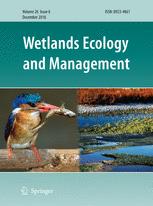View Item
- xmlui.general.dspace_homeCentros Regionales y EEAsCentro Regional Patagonia NorteEEA BarilocheArtículos científicosxmlui.ArtifactBrowser.ItemViewer.trail
- DSpace Home
- Centros Regionales y EEAs
- Centro Regional Patagonia Norte
- EEA Bariloche
- Artículos científicos
- View Item
Particulate organic carbon is a sensitive indicator of soil degradation related to overgrazing in Patagonian wet and mesic meadows
Abstract
Patagonian meadows are key for the development and sustainability of rural environments. However, they have been degraded due to a combination of weather conditions and overgrazing. Total soil organic carbon (TOC) has been found as a moderate indicator of meadow soil degradation by long-term heavy grazing. The aim of this study was to evaluate the particulate organic carbon (POC) (a more labile fraction of the soil organic matter) as an ecological
[ver mas...]
Patagonian meadows are key for the development and sustainability of rural environments. However, they have been degraded due to a combination of weather conditions and overgrazing. Total soil organic carbon (TOC) has been found as a moderate indicator of meadow soil degradation by long-term heavy grazing. The aim of this study was to evaluate the particulate organic carbon (POC) (a more labile fraction of the soil organic matter) as an ecological indicator for assessing soil changes in natural Patagonian meadows, related to different longterm grazing managements. We worked in three locations along a precipitation gradient in Northern
Patagonia. Each location has wet and mesic meadows with good and poor grassland condition, attributed to two long-term grazing pressures (light and heavy). We sampled soil throughout the plant-growing season following the natural soil moisture fluctuations, and
quantified the POC content, the POC:TOC ratio, and the F[53 proportion. Along the different sampling dates, significant differences between good versus poor grassland condition were found in many cases in POC, a few in POC:TOC ratio, and none in F[53
proportion. The POC varies over time, in association with changes in the soil moisture (adjusted R2 vary between 0.76 and 0.99); therefore, the sampling date must be standardized (we recommend dry periods).
The POC appears to be a sensitive indicator when assessing the effect of different soil management practices on soil quality, an important step for meadow conservation, restoration and sustainable use, but further research is needed to validate this exploratory
study.
[Cerrar]

Fuente
Wetlands Ecology and Management 26 (3) : 345-357 (June 2018)
Date
2018-06
Editorial
Springer
ISSN
0923-4861
Formato
pdf
Tipo de documento
artículo
Palabras Claves
Derechos de acceso
Restringido
 Excepto donde se diga explicitamente, este item se publica bajo la siguiente descripción: Creative Commons Attribution-NonCommercial-ShareAlike 2.5 Unported (CC BY-NC-SA 2.5)
Excepto donde se diga explicitamente, este item se publica bajo la siguiente descripción: Creative Commons Attribution-NonCommercial-ShareAlike 2.5 Unported (CC BY-NC-SA 2.5)

